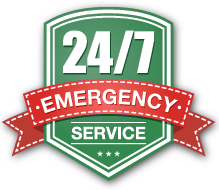Do you know the dangers of carbon monoxide?
1) WHAT IS CARBON MONOXIDE?
- Carbon Monoxide is a colorless, odorless and tasteless poison gas that can be fatal when inhaled.
- It is sometimes called the “silent killer.”
- CO inhibits the blood’s capacity to carry oxygen.
- CO can be produced when burning fuels such as gasoline, propane, natural gas, oil or wood.
- CO is the product of incomplete combustion. If you have fire, you have CO.
2) WHERE DOES CARBON MONOXIDE COME FROM?
- Any fuel-burning appliance that is malfunctioning or improperly installed.
- Furnaces, gas range/stove, gas clothes dryer, water heater, portable fuel-burning space heaters, fireplaces, generators and wood burning stoves.
- Vehicles, generators and other combustion engines running in an attached garage.
- Blocked chimney or flue.
- Cracked or loose furnace exchanger.
- Back drafting and changes in air pressure.
- Operating a grill in an enclosed space.
3) WHAT ARE CARBON MONOXIDE POISONING SYMPTOMS?
Initial symptoms are similar to the flu without a fever and can include dizziness, severe headaches, nausea, sleepiness, fatigue/weakness and disorientation/confusion.
4) WHAT ARE THE EFFECTS OF CARBON MONOXIDE EXPOSURE?
- Common Mild Exposure – Slight headache, nausea, vomiting, fatigue, flu-like symptoms.
- Common Medium Exposure – Throbbing headache, drowsiness, confusion, fast heart rate.
- Common Extreme Exposure – Convulsions, unconsciousness, brain damage, heart and lung failure followed by death.
- If you experience even mild CO poisoning symptoms, immediately consult a physician!
5) ARE THERE ANY STEPS I CAN TAKE TO PREVENT CARBON MONOXIDE POISONING?
- Properly equip your home with carbon monoxide alarms on every level and in sleeping areas. The only safe way to detect CO in your home is with a CO alarm.
- Every year have the heating system, vents, chimney and flue inspected by a qualified technician.
- Regularly examine vents and chimneys for improper connections, visible rust and stains.
- Install and operate appliances according to the manufacturer’s instructions.
- Only purchase appliances that have been approved by a nationally recognized testing laboratory.
- Never use a gas range/stove to heat the home.
- Never leave your car idling in a closed garage or use fuel-powered appliances or tools in enclosed, attached areas such as garages or porches. Carbon monoxide can seep into your home through vents and doors.
6) DO I NEED A CARBON MONOXIDE ALARM? WHERE SHOULD IT BE INSTALLED?
- Every home with at least one fuel-burning appliance/heater, attached garage or fireplace should have a carbon monoxide alarm.
- If the home has only one carbon monoxide alarm, it should be installed in the main bedroom or in the hallway outside of the sleeping area.
- An alarm should be installed on every level of the home and in sleeping areas.
- Place the alarm at least 15 feet away from fuel-burning appliances.
- Make sure nothing is covering or obstructing the unit.
- Do not place the unit in dead air spaces or next to a window or door.
- Test the carbon monoxide alarm once a week by pressing the test/reset button.
- Every month, unplug the unit and vacuum with a soft-brush attachment or wipe with a clean, dry cloth to remove accumulated dust.
7) SHOULD MY CARBON MONOXIDE ALARM HAVE A DIGITAL DISPLAY? WHAT DOES THE PEAK LEVEL FUNCTION DO?
A digital display allows you to see if CO is present and respond before it becomes a dangerous situation.
Peak Level Memory stores the highest recorded reading prior to being reset. This feature enables you to know if there was a reading while you were away from home, and also can help emergency responders determine the best treatment.
8) WHO SHOULD I CALL IF MY CARBON MONOXIDE ALARM GOES OFF?
If anyone is experiencing symptoms, you need to get everyone into fresh air and call 911 from a neighbor’s home. If no one is experiencing symptoms, you should call the fire department or a qualified technician from a neighbor’s home to have the problem inspected. If you are unable to leave the home to call for help, open the doors and windows, and turn off all possible sources while you are waiting for assistance to arrive. Under no circumstance should an alarm be ignored!
Contact Our Residential Home Inspection Experts
At Albuquerque Plumbing, Heating & Cooling, we provide fast, reliable service with a 100% guarantee. Our goal is to make certain that your plumbing and HVAC systems are working efficiently and providing your family the comfort you need. With our residential inspection service, you’ll never have to worry about the condition of your plumbing, heating, or cooling systems. Contact Albuquerque Plumbing, Heating & Cooling to schedule your residential home inspection.
Call (505) 349-4404 today to schedule our residential inspection service!



